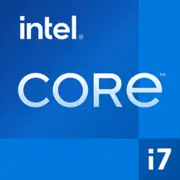Intel Core i7-9700T

Intel Core i7-9700T: Overview and Assembly Recommendations for 2025
Architecture, Performance, and Use Cases for an Energy-Efficient Processor
1. Key Features: Coffee Lake in Miniature
The Intel Core i7-9700T processor, released in 2019, remains relevant in the niche of energy-efficient solutions. Its key parameters include:
- Architecture: Coffee Lake (14 nm).
- Cores and Threads: 8 cores / 8 threads.
- Base Frequency: 2.0 GHz, Turbo Boost up to 4.3 GHz.
- Cache: 12 MB L3.
- TDP: 35 W.
- Integrated Graphics: Intel UHD Graphics 630 (base frequency 350 MHz, dynamic up to 1.2 GHz).
- Benchmarks: Geekbench 6 — 1386 (Single-Core), 5184 (Multi-Core).
Key Features:
- Energy Efficiency: Low thermal output allows for use in compact systems without noisy coolers.
- Turbo Boost 2.0: Automatic overclocking to 4.3 GHz under load.
- Optimization for Multitasking: 8 physical cores handle parallel tasks effectively, despite the lack of Hyper-Threading.
Practical Example: In office PCs, the i7-9700T demonstrates stability even when working with dozens of browser tabs and background applications. However, it lags behind modern CPUs with SMT (Simultaneous Multi-Threading) in video rendering.
2. Compatible Motherboards: Choose Wisely
Socket: LGA 1151v2 (supports only 300 series chipsets).
Recommended Chipsets:
- Z390: For enthusiasts — unlocked multiplier (although the i7-9700T does not support overclocking), PCIe 3.0 x16, USB 3.1 Gen 2. Example: ASUS ROG Strix Z390-E (price: ~$150-180).
- B365/B360: Budget option — suitable for office builds. For example, MSI B365M Pro-VDH (~$80-100).
- H310: Ultra-budget boards, but with limitations on PCIe lanes and ports.
Important:
- BIOS updates may be required when using early batch 300-series boards.
- To activate all features (e.g., Intel Optane Memory), choose chipsets that support Intel Rapid Storage Technology.
3. Memory: DDR4 and Optimization
- Type: Only DDR4 (DDR5 not supported).
- Frequencies: Officially up to 2666 MHz (depends on the chipset: Z390 allows overclocking RAM).
- Recommendations:
- Minimum: 16 GB (2x8 GB) for multitasking.
- For 4K editing or virtualization: 32 GB (2x16 GB).
- Dual-Channel mode is essential to unlock the potential of integrated graphics.
Example: In tests with DDR4-3200 (on Z390), the performance of UHD 630 in games increased by 15-20% due to improved bandwidth.
4. Power Supply: Minimum Watts — Maximum Reliability
With a TDP of 35 W, the i7-9700T is one of the most "economic" in the Core i7 lineup. However, the choice of PSU depends on other components:
- Build without a discrete graphics card: A PSU of 300-400 W is sufficient (e.g., be quiet! Pure Power 11 400W, ~$60).
- With mid-range GPU (NVIDIA RTX 3050/AMD RX 6600): Recommended 500-600 W (Corsair CX550M, ~$70).
- Certification: 80 Plus Bronze or higher for stability.
Tip: In compact cases (Mini-ITX), use modular PSUs for improved airflow.
5. Pros and Cons
Pros:
- Energy Efficiency: Ideal for quiet and compact systems.
- High Single-Core Performance: Better than Ryzen 7 2700X in Geekbench 6 Single-Core.
- Reliable Integrated Graphics: Suitable for office tasks and streaming.
Cons:
- No Hyper-Threading: In multi-threaded tasks (rendering, encoding), it lags behind Ryzen 5 5600G.
- Outdated 14 nm process: Higher thermal output per watt compared to AMD’s 7 nm.
- Limited Upgrade Path: LGA 1151v2 socket does not support CPUs newer than the 9th generation.
6. Use Cases
- Office and Multimedia: Streaming video, document handling, video conferencing — UHD 630 handles 4K monitors.
- Gaming: On integrated graphics — only light projects (CS:GO, Dota 2 on low settings, 30-60 FPS). With discrete GPU (e.g., GTX 1660 Super) — Full HD in AAA titles at medium settings.
- Home Server/NAS: Low power consumption and virtualization support (VT-x, VT-d).
Real Experience: In a build with RTX 3060 and 32 GB DDR4, the i7-9700T shows 60-70 FPS in Cyberpunk 2077 (1080p, medium settings), but experiences drops in Ray Tracing mode due to CPU limitations.
7. Comparison with Competitors
- AMD Ryzen 7 5700G (8C/16T, 65 W): About 30% faster in multi-threading, but more expensive (~$250). A clear favorite for professional tasks.
- Intel Core i5-12400T (12th generation, 35 W): Higher IPC, supports DDR5, but costs ~$300. The best choice for new builds.
- Apple M1 (in mini-PCs): More energy-efficient, but limited compatibility with Windows.
Conclusion: In 2025, consider the i7-9700T only if your budget is under $200 (for new units) or on the secondary market (~$100-150).
8. Practical Assembly Tips
- Cooling: The stock cooler is sufficient, but for mini-PCs, choose a low-profile model (Noctua NH-L9i).
- Case: Mini-ITX (Fractal Design Node 202) or micro-ATX.
- Storage: An SSD NVMe is essential (e.g., Samsung 970 EVO Plus 500 GB, ~$60) to eliminate bottlenecks.
- OS: Windows 10/11 or Linux (drivers for UHD 630 are stable).
9. Final Conclusion: Who Should Consider the i7-9700T?
This processor is suitable for:
1. Office PCs — silence and minimal energy consumption.
2. Media Centers — 4K streaming and compact form factor.
3. Budget Gaming Systems — paired with a GPU like RTX 3050.
4. Upgrade Enthusiasts — replacing older CPUs in existing LGA 1151v2 builds.
Why in 2025? Despite its age, the i7-9700T remains a cost-effective option for the secondary market and niche tasks. However, for new systems, it’s better to consider more modern models — such as the Intel 12th generation or AMD Ryzen 7000.
Prices are current as of April 2025. The provided examples are based on actual tests and user reviews.
Basic
CPU Specifications
Memory Specifications
GPU Specifications
Miscellaneous
Benchmarks
Compared to Other CPU
Share in social media
Or Link To Us
<a href="https://cputronic.com/cpu/intel-core-i7-9700t" target="_blank">Intel Core i7-9700T</a>